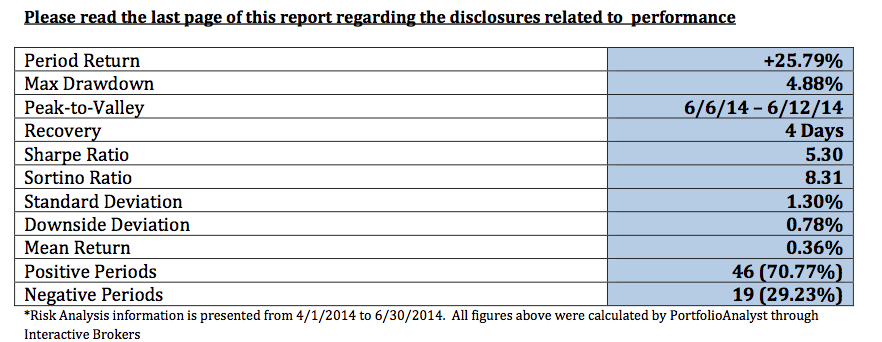The second quarter of 2014 was strong for the Select Sector Plus portfolio. The strategy benefitted from the volatility position added in April as well as full exposure to equities for the entire quarter.
Total return for the quarter was +25.79% compared to the S&P 500 Total Return Index returning +5.23%. A breakdown of the strategy’s performance and risk analysis are shown on the table below. The second quarter of 2014 is a good example of how our actively managed strategy can provide significant outperformance in up-markets, which we believe is a great value. We always aim to deliver risk adjusted returns across multiple market cycles.
Domestic Equity:
The domestic equity market was up +5.23% for the second quarter of 2014. There were two outliers relative to the market and the other sectors which are worth noting. Financials (XLF) was a clear underperformer for the quarter with a +2.20% return and energy (XLE) posted a large gain of +12.92%. Our strategy signaled a fully invested position in every domestic equity sector for the second quarter as each was in a clear uptrend with low levels of volatility.
Volatility for the market and each sector individually has drifted lower in the second quarter. Although the VIX has been at levels not seen since 2007; implied (forward looking) volatility relative to realized (historic) volatility remains fairly consistent to historic ratios.
Our allocation to volatility as an asset class was a large piece of our outperformance this quarter; these types of environments can be opportunities for our portfolios to appreciate substantially. Risk management is paramount when allocating to volatility and we can move to a neutral (cash) position quickly if need be. Market environments like the second quarter are optimal for our strategies and we’d expect to see substantial outperformance relative to the S&P 500 in those times.
Economic Developments
Unrest in Syria and Iraq due to the radical Sunni militants known as ISIS could inject volatility back into the markets at a moment’s notice. Thus far it seems markets have shrugged off any effect that this could have on oil prices however that could change quickly and dramatically.
Also, the Federal Reserve continues to stay the course on its plan to scale back the asset purchase program known as “QE” by reducing purchases by another $10 billion per month. It is still too soon to determine what long term affects either of these situations will have on the markets; however we’ll monitor each closely.
Employment data in the US continues to improve as the unemployment rate has come down to 6.1% and the economy seems to be consistently adding over 200k jobs per month. A strengthening job market, and thus a stronger consumer, would be a tailwind to the market and could push prices higher.
Earnings season is about to begin and should determine the trend in the third quarter. Analyst expectations have come down a bit recently and it will be interesting to see how many companies are able to beat the reduced expectations. Active risk management and prudent investing should be increasingly important to make sure assets are protected through these market environments.
Current Portfolio
As of 6/30/2014 the portfolio was invested in all 9 sectors of the S&P 500, along with short exposure to volatility (VXX). As of 7/11/2014 (today) we haven’t made any changes to those allocations. Because we run systematic, model based portfolios we don’t make market or sector predictions, however we’ll state that there is a small buffer before any of the equity sectors would be removed from our portfolios and the volatility position doesn’t look quite as attractive now as it did over the course of last quarter.
An increase in the volatility of any sectors, a sustained move downward in price, or a combination of the two could result in there being dramatic and quick changes in the portfolio.
DISCLAIMER: The investments discussed are held in client accounts as of June 30, 2013. These investments may or may not be currently held in client accounts. The reader should not assume that any investments identified were or will be profitable or that any investment recommendations or investment decisions we make in the future will be profitable. Past performance is no guarantee of future results.



